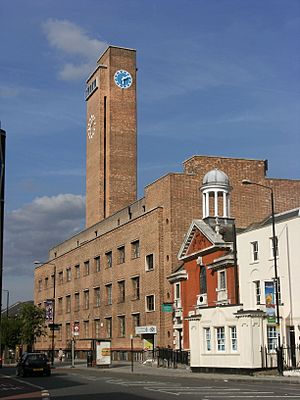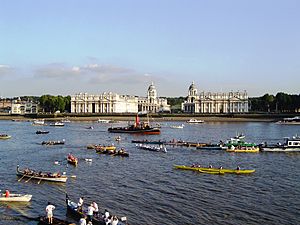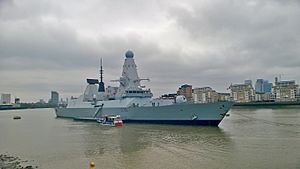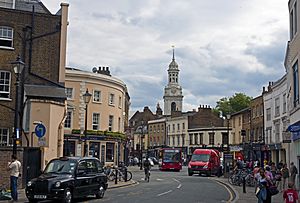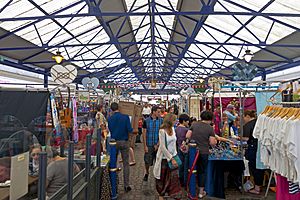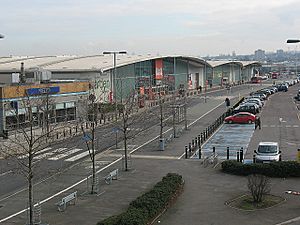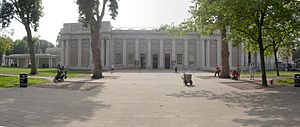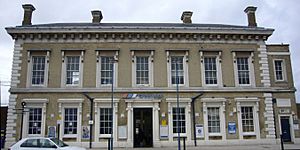Greenwich facts for kids
Quick facts for kids Greenwich |
|
|---|---|
 Royal Observatory, Greenwich |
|
| Population | 30,578 (Peninsula and Greenwich West wards 2011) |
| OS grid reference | TQ395775 |
| • Charing Cross | 5.5 mi (8.9 km) WNW |
| London borough | |
| Ceremonial county | Greater London |
| Region | |
| Country | England |
| Sovereign state | United Kingdom |
| Post town | LONDON |
| Postcode district | SE10 |
| Dialling code | 020 |
| Police | Metropolitan |
| Fire | London |
| Ambulance | London |
| EU Parliament | London |
| UK Parliament |
|
| London Assembly |
|
Greenwich (pronounced GREN-itch or GRIN-ij) is a famous town in south-east London, England. It's about 5.5 miles (9 km) east-south-east of Charing Cross, a central point in London.
Greenwich is well-known for its amazing maritime history, meaning its connection to the sea and ships. It's also where the Greenwich Meridian (0° longitude) and Greenwich Mean Time (GMT) get their names. These are super important for navigation and telling time around the world!
For a long time, Greenwich was home to a royal palace called the Palace of Placentia. Many famous Tudor kings and queens were born here, including Henry VIII and Elizabeth I. After the palace was torn down, the Royal Naval Hospital for Sailors was built in its place. This grand building was designed by famous architects like Sir Christopher Wren. Later, it became the Old Royal Naval College, a place for military education. Today, you can visit its historic rooms, and parts of the buildings are used by the University of Greenwich and Trinity Laban Conservatoire of Music and Dance.
In the 1700s, Greenwich became a popular place to visit, and many beautiful houses were built. The town's connection to the sea grew even stronger in the 1900s. Famous ships like the Cutty Sark and Gipsy Moth IV were brought here. The National Maritime Museum also opened, celebrating Britain's naval past.
Greenwich used to be a small parish in Kent. But as London grew, it became part of the big city. In 1965, it joined with parts of Woolwich to form the Royal Borough of Greenwich, which is now a special district of Greater London.
Contents
- History of Greenwich
- How Greenwich is Governed
- Greenwich's Location
- Cool Places to See in Greenwich
- Greenwich Mean Time (GMT)
- World Heritage Site
- Discover Greenwich Visitor Centre
- Learning in Greenwich
- Getting Around Greenwich
- Sports in Greenwich
- Greenwich's Twin Towns
- Literature Connection
- Images for kids
- See also
History of Greenwich
What's in a Name?
The name 'Greenwich' is very old! It first appeared in a document from 918 as Gronewic. It means 'green wic', where 'wic' was an old word for a trading place or port. So, Greenwich was likely a green trading spot by the river.
For a while, it was called East Greenwich to tell it apart from West Greenwich (which was part of Deptford). But over time, everyone just called the whole town Greenwich.
East Greenwich and America
Did you know that Greenwich is connected to the founding of some places in America? When English settlers were given land in North America, their land was often described as being held "as of his Majesty's manor of East Greenwich." This was a legal way to say that the land was owned under English law, even though it was far away. This is why some places in the United States, like East Greenwich in New Jersey and Rhode Island, share the name!
Early Life in Greenwich
Long, long ago, people lived in Greenwich. In Greenwich Park, you can still see old burial mounds from the early Bronze Age. These were later used by the Saxons for burials in the 6th century. There's also a spot where a Roman villa or temple once stood. Archeologists found over 300 Roman coins there!
The famous Roman road from London to Dover, called Watling Street, passed through the high ground south of Greenwich. Back in the time of Henry V, Greenwich was mostly a fishing town with a safe place for boats to anchor in the river.
Viking Visitors
Around the year 1000, during the reign of King Ethelred the Unready, Viking ships stayed in the River Thames off Greenwich for more than three years. Their army camped on the hill above the town. In 1012, they captured the city of Canterbury and took Archbishop Alphege prisoner. He was held in their camp at Greenwich for seven months. When he refused to let his ransom be paid, they killed him. Because of this, he became a saint, and the local church was named St Alfege's Church in his honor. The church you see today was designed by Nicholas Hawksmoor and finished in 1718.
Royal Connections Begin
By the time of the Domesday Book in 1086, Greenwich was already a manor. A royal palace or hunting lodge existed here even before 1300, as King Edward I visited often.
Later, Humphrey, Duke of Gloucester, a brother of King Henry V, made the palace even grander in 1447. He also created Greenwich Park and built a tower on the hill where the Royal Observatory now stands. The palace by the Thames was renamed the Palace of Placentia (or Pleasaunce) by Queen Margaret of Anjou.
Because the palace and its grounds were owned by the royal family, and because it had a useful hill, it was chosen as the site for King Charles II's Royal Observatory. This decision led to Greenwich's worldwide fame as the starting point for the modern Prime Meridian.
Tudor Times
The Palace of Placentia was a favorite home for Henry VII. His sons, Henry (who became Henry VIII) and Edmund Tudor, were born and baptized here. Henry VIII loved Greenwich more than his other palaces because it was right on the River Thames, making it easy to reach by boat. He expanded the palace, and it became his main home in London for a while.
Henry VIII married two of his wives, Catherine of Aragon and Anne of Cleves, at Greenwich. And two of England's most famous queens, Mary I and Elizabeth I, were born right here in Greenwich! His son, Edward VI, also passed away here when he was just 15.
The palace continued to be a favorite summer home for Queen Elizabeth I. She and her sister Mary used it a lot. In 1588, Elizabeth's advisors even planned the defense against the Spanish Armada from Greenwich.
Stuart Era and New Buildings
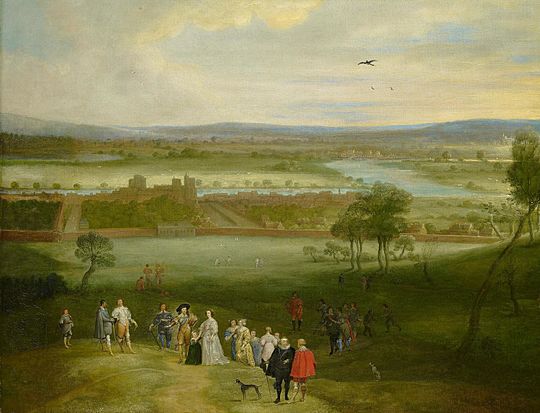
King James I made some final changes to Greenwich Palace. His wife, Queen Anne, asked Inigo Jones to design and build the beautiful Queen's House, which you can still see today.
During the English Civil War, the palace was used as a biscuit factory and a place for prisoners of war. After the war, the old palace was torn down. King Charles II started building a grand new palace, but only one part, the King Charles block, was finished. Charles II also redesigned Greenwich Park and founded the Royal Observatory.
Later, King James II had the idea for a Royal Naval Hospital. His daughter, Mary II, made it happen. She asked Christopher Wren to design the Royal Hospital for Seamen (now the Old Royal Naval College). The building work started in 1696 and was finished by Nicholas Hawksmoor.
Modern Greenwich
In 1838, the London and Greenwich Railway opened the first steam railway in London, with its station in Greenwich. This was a big deal because it was the first railway built just for passengers!
The Prime Meridian was officially set in Greenwich in 1851.
Many members of the Royal Family have supported Greenwich. King George V and Queen Mary helped create the National Maritime Museum. In 1937, King George VI opened the museum in the buildings that used to be the Royal Hospital School.
In 2012, to celebrate Queen Elizabeth II's Diamond Jubilee, the London Borough of Greenwich was given the special title of "Royal Borough." This was to honor its long history with the Royal Family, its role as the home of the Prime Meridian, and its status as a World Heritage Site.
How Greenwich is Governed
Greenwich is part of the Royal Borough of Greenwich. This borough was created in 1965 by joining the old Metropolitan Borough of Greenwich with part of Woolwich. People in Greenwich vote for a Member of Parliament (MP) to represent them in the UK government. The current MP for Greenwich and Woolwich is Matthew Pennycook.
Greenwich's Location
Greenwich Geography
Greenwich is built on a flat area next to a bend in the River Thames. The river here is deep and safe for ships to anchor. To the south, the land rises steeply through Greenwich Park up to the town of Blackheath. The soil in the higher areas is gravelly, while closer to the river, you'll find sand, loam, and clay.
Greenwich is next to Deptford to the west, Westcombe Park to the east, the River Thames to the north, and Blackheath to the south. The Greenwich Peninsula (also called North Greenwich) sticks out into the river to the northeast.
Nearby Places
- Blackheath
- Charlton
- Deptford
- Greenwich Peninsula
- Eltham
- Kidbrooke
- Lewisham
- New Cross
- Plumstead
- Shooters Hill
- Surrey Quays
- Thamesmead
- Westcombe Park
- Woolwich
- Welling
- Falconwood
- Abbey Wood
Greenwich Weather
Greenwich has a mild climate with warm summers and cool winters. The weather station in Greenwich collected this data between 2005 and 2015:
| Climate data for London (Greenwich) | |||||||||||||
|---|---|---|---|---|---|---|---|---|---|---|---|---|---|
| Month | Jan | Feb | Mar | Apr | May | Jun | Jul | Aug | Sep | Oct | Nov | Dec | Year |
| Record high °C (°F) | 14.0 (57.2) |
19.7 (67.5) |
21.0 (69.8) |
26.9 (80.4) |
31.0 (87.8) |
35.0 (95.0) |
35.5 (95.9) |
37.5 (99.5) |
30.0 (86.0) |
28.8 (83.8) |
19.9 (67.8) |
15.0 (59.0) |
37.5 (99.5) |
| Mean daily maximum °C (°F) | 8.3 (46.9) |
8.5 (47.3) |
11.4 (52.5) |
14.2 (57.6) |
17.7 (63.9) |
20.7 (69.3) |
23.2 (73.8) |
22.9 (73.2) |
20.1 (68.2) |
15.6 (60.1) |
11.4 (52.5) |
8.6 (47.5) |
15.2 (59.4) |
| Mean daily minimum °C (°F) | 2.6 (36.7) |
2.4 (36.3) |
4.1 (39.4) |
5.4 (41.7) |
8.4 (47.1) |
11.5 (52.7) |
13.9 (57.0) |
13.7 (56.7) |
11.2 (52.2) |
8.3 (46.9) |
5.1 (41.2) |
2.8 (37.0) |
7.5 (45.5) |
| Record low °C (°F) | −10.0 (14.0) |
−9.0 (15.8) |
−8.0 (17.6) |
−2.0 (28.4) |
−1.0 (30.2) |
5.0 (41.0) |
7.0 (44.6) |
6.0 (42.8) |
3.0 (37.4) |
−4.0 (24.8) |
−5.0 (23.0) |
−7.0 (19.4) |
−10.0 (14.0) |
| Average precipitation mm (inches) | 51.6 (2.03) |
38.2 (1.50) |
40.5 (1.59) |
45.0 (1.77) |
46.5 (1.83) |
47.3 (1.86) |
41.1 (1.62) |
51.6 (2.03) |
50.4 (1.98) |
68.8 (2.71) |
58.0 (2.28) |
53.0 (2.09) |
591.8 (23.30) |
| Average rainy days (≥ 1.0 mm) | 10.8 | 8.5 | 9.6 | 9.4 | 9.0 | 8.3 | 8.0 | 7.6 | 8.5 | 10.7 | 10.1 | 9.9 | 110.4 |
| Average snowy days | 4 | 4 | 3 | 1 | 0 | 0 | 0 | 0 | 0 | 0 | 1 | 3 | 16 |
| Average relative humidity (%) | 81.0 | 76.0 | 69.0 | 64.0 | 62.0 | 60.0 | 60.0 | 62.0 | 67.0 | 73.0 | 78.0 | 82.0 | 69.5 |
| Mean monthly sunshine hours | 49.9 | 71.4 | 107.1 | 159.8 | 181.2 | 181.0 | 192.1 | 195.1 | 138.9 | 108.1 | 58.5 | 37.4 | 1,480.5 |
| Source 1: Record highs and lows from BBC Weather, except August and February maximum from Met Office | |||||||||||||
| Source 2: All other data from Met Office, except for humidity and snow data which are from NOAA | |||||||||||||
| Climate data for London (Heathrow airport 1981−2010) | |||||||||||||
|---|---|---|---|---|---|---|---|---|---|---|---|---|---|
| Month | Jan | Feb | Mar | Apr | May | Jun | Jul | Aug | Sep | Oct | Nov | Dec | Year |
| Mean daily maximum °C (°F) | 8.1 (46.6) |
8.4 (47.1) |
11.3 (52.3) |
14.2 (57.6) |
17.9 (64.2) |
21.0 (69.8) |
23.5 (74.3) |
23.2 (73.8) |
19.9 (67.8) |
15.5 (59.9) |
11.1 (52.0) |
8.3 (46.9) |
15.2 (59.4) |
| Mean daily minimum °C (°F) | 2.3 (36.1) |
2.1 (35.8) |
3.9 (39.0) |
5.5 (41.9) |
8.7 (47.7) |
11.7 (53.1) |
13.9 (57.0) |
13.7 (56.7) |
11.4 (52.5) |
8.4 (47.1) |
4.9 (40.8) |
2.7 (36.9) |
7.4 (45.4) |
| Average precipitation mm (inches) | 55.2 (2.17) |
40.9 (1.61) |
41.6 (1.64) |
43.7 (1.72) |
49.4 (1.94) |
45.1 (1.78) |
44.5 (1.75) |
49.5 (1.95) |
49.1 (1.93) |
68.5 (2.70) |
59.0 (2.32) |
55.2 (2.17) |
601.7 (23.68) |
| Average rainy days (≥ 1.0 mm) | 11.1 | 8.5 | 9.3 | 9.1 | 8.8 | 8.2 | 7.7 | 7.5 | 8.1 | 10.8 | 10.3 | 10.2 | 109.6 |
| Mean monthly sunshine hours | 61.5 | 77.9 | 114.6 | 168.7 | 198.5 | 204.3 | 212.0 | 204.7 | 149.3 | 116.5 | 72.6 | 52.0 | 1,632.6 |
| Source: Met Office | |||||||||||||
Cool Places to See in Greenwich
By the River
The famous clipper ship, the Cutty Sark, is preserved in a dry dock right by the river. It's an amazing old sailing ship! Nearby, for many years, was Gipsy Moth IV, the yacht that Sir Francis Chichester sailed all the way around the world by himself in 1966–67.
Close to the Cutty Sark, you'll find the entrance to the Greenwich foot tunnel. This tunnel, opened in 1902, goes under the River Thames and connects Greenwich to the Isle of Dogs on the other side. From the north exit, at Island Gardens, you can get a fantastic view of the Greenwich Hospital buildings, just like in the famous paintings by Canaletto.
Rowing has been a part of life on the Thames in Greenwich for hundreds of years. The annual Great River Race, a big boat race, finishes right here at the Cutty Sark.
The Old Royal Naval College is a stunning building designed by Sir Christopher Wren. It's a key part of the Greenwich heritage site. Inside, you can see the incredible Painted Hall, with its amazing ceiling paintings by James Thornhill, and the beautiful Chapel of St Peter and St Paul.
East of the Naval College is the Trinity Hospital almshouse. It was founded in 1613 and is the oldest building still standing in the town center. Next to it are the huge brick walls of Greenwich Power Station. This station was built over 100 years ago to power London's trams and later the underground trains.
The O2 (which used to be called the Millennium Dome) is a huge entertainment arena built on the Greenwich Peninsula. It's about 3 miles (5 km) northeast of Greenwich town center. The Greenwich Millennium Village is a modern housing development nearby.
Greenwich Park Fun
South of the Old Royal Naval College is the National Maritime Museum. This museum is housed in grand buildings that include the beautiful Queen's House, designed by Inigo Jones.

Continuing south, you'll find Greenwich Park, a huge Royal Park covering 183 acres (0.74 km²). It was created in the 1600s from the hunting grounds of the old royal palace.
The park goes uphill towards Blackheath. At the top of the hill, you'll see a statue of James Wolfe, a famous British commander. Nearby are the buildings of the former Royal Observatory, Greenwich. This is where the Prime Meridian line passes through!
Greenwich Mean Time (GMT) was once based on observations made at the Royal Greenwich Observatory. Even though it's not a working observatory anymore, a time ball still drops every day at 1 p.m. to mark the exact time. There's also a museum with cool astronomical and navigation tools, including John Harrison's amazing clocks.
Greenwich Town Centre
The town center of Greenwich has many beautiful Georgian and Victorian buildings, especially around the covered Greenwich Market. Up the hill from the center, you'll find streets with more Georgian houses, including the Fan Museum. The Greenwich Theatre is also in this area.
Greenwich Market
Greenwich has had a market since the 1300s! The current market dates back to 1700. The buildings around the market are very old and were built between 1827 and 1833. A roof was added to the market in the early 1900s. Today, it's a lively place with many different stalls.
Millennium Leisure Park
About a mile (1.6 km) east of Greenwich town center, you'll find the Millennium Leisure Park. This is a shopping area with big stores like IKEA and B&Q, along with restaurants and an Odeon cinema.
Greenwich Mean Time (GMT)

Greenwich Mean Time (GMT) originally meant the average solar time at the Royal Observatory, Greenwich. This observatory sits on a hill overlooking the River Thames. GMT is often used to refer to Coordinated Universal Time (UTC), which is a very precise atomic time scale.
As Britain became a powerful maritime nation, British sailors used clocks set to GMT to figure out their longitude (their east-west position) from the Greenwich meridian. This meridian was agreed to be 0 degrees longitude for the whole world in 1884. This practice led to GMT becoming a worldwide reference time. Most time zones around the globe are based on how many hours they are "ahead of GMT" or "behind GMT."
To honor Greenwich's connection to space and time, a small planet (called Asteroid 2830) has been named 'Greenwich'!
World Heritage Site
| UNESCO World Heritage Site | |
|---|---|
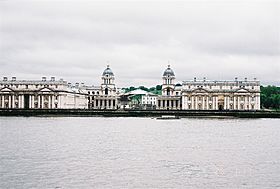
Old Royal Naval College and University of Greenwich buildings by the River Thames.
|
|
| Location | United Kingdom |
| Criteria | Cultural: i, ii, iv, vi |
| Inscription | 1997 (21st Session) |
| Extensions | 2008 |
| Area | 109.5 hectares (271 acres) |
| Buffer zone | 174.85 hectares (432.1 acres) |
In 1997, the area known as Maritime Greenwich was added to the list of World Heritage Sites. This is a very special honor given by UNESCO. It means the area has incredible historical and architectural importance. The site includes the beautiful buildings along the river, Greenwich Park, and the historic town center.
Discover Greenwich Visitor Centre
The Discover Greenwich Visitor Centre is a great place to learn about the history of Greenwich and all its attractions. It's located in The Pepys Building, close to the Cutty Sark, within the grounds of the Old Royal Naval College. The center opened in 2010, and it's free to enter!
The center teaches you about Greenwich's past as a royal home and a major maritime hub. Some of the cool things you can see include:
- The history of the Palace of Placentia.
- Models of Christopher Wren's first designs for Greenwich Hospital.
- Parts of the carved heads that were meant to decorate the outside of the college's Painted Hall.
- Displays about Maritime Greenwich and its connections to the sea and famous explorations.
- An exhibition called "By Wisdom as much as War" about the history of the Old Royal Naval College when it was a naval training school (from 1873 to 1998).
Learning in Greenwich
The main campus of the University of Greenwich is in the grand riverside buildings of the former Old Royal Naval College. There are also other university campuses nearby. The Greenwich campus also houses the Trinity College of Music, a famous music school.
Greenwich has several secondary schools, including The John Roan School, which was founded way back in 1677, and St Ursula's Convent School, started in 1850.
Getting Around Greenwich
Trains
Greenwich has two train stations: Greenwich and Maze Hill. You can catch Southeastern trains to places like London Cannon Street and Dartford. Thameslink trains also go to Luton and Rainham.
London Underground (Tube)
The North Greenwich station is on the Jubilee Line. You can take the tube from here to Stanmore or Stratford.
DLR (Docklands Light Railway)
The Docklands Light Railway (DLR) serves Greenwich. You can get on the DLR at Greenwich and Cutty Sark stations. It connects to places like Bank (in central London) and Lewisham.
Buses
Many London Buses routes serve Greenwich, connecting it to different parts of London. Some popular routes include:
- 129 to Lewisham Shopping Centre or North Greenwich
- 177 to Peckham or Thamesmead
- 188 to North Greenwich or Russell Square
- 199 to Bellingham or Canada Water
- 286 to Sidcup
- 386 to Blackheath or Woolwich
- Night buses like N1 and N199 also run through Greenwich.
Boats
You can take a river boat from Greenwich Pier! Thames Clippers run a fast catamaran service to places like Embankment and Woolwich Arsenal Pier. There are also tourist cruises that go to Westminster and Tower Bridge.
Walking and Cycling
The Thames Path is a walking trail that runs along the riverside. The Greenwich foot tunnel is also great for pedestrians to cross under the Thames. The National Cycle Network Route 1 includes the foot tunnel, but you have to walk your bike through it.
Sports in Greenwich
Rowing Fun
Greenwich is a great place for rowing because it's right on the River Thames. The Trafalgar Rowing Centre is home to the Curlew and Globe rowing clubs. The Globe club is especially known for its young rowers who do very well in national and international competitions!
Running Routes
Greenwich Park and the Thames Path are popular spots for runners. The famous London Marathon has one of its starting points (the 'red start') just south of Greenwich Park. Runners pass by the Old Royal Naval College and the Cutty Sark as they make their way through Greenwich.
Golfing in Greenwich
The Greenwich Peninsula Golf Range in North Greenwich is a cool place to practice your golf swing. It has 60 bays, a mini 18-hole adventure course, and even a golf academy!
Greenwich's Twin Towns
Greenwich has special connections with other towns around the world, called "twin towns" or "sister cities":
 Maribor, Slovenia
Maribor, Slovenia Reinickendorf, Berlin, Germany
Reinickendorf, Berlin, Germany Tema, Ghana
Tema, Ghana Hangzhou, China
Hangzhou, China
Literature Connection
The famous writer Edward Lear mentioned Greenwich in one of his funny poems:
There was a young lady of Greenwich,
Whose garments were bordered with Spinach;
But a large spotty calf
Bit her shawl quite in half,
Which alarmed that young lady of Greenwich.
Images for kids
See also
 In Spanish: Greenwich (distrito) para niños
In Spanish: Greenwich (distrito) para niños




